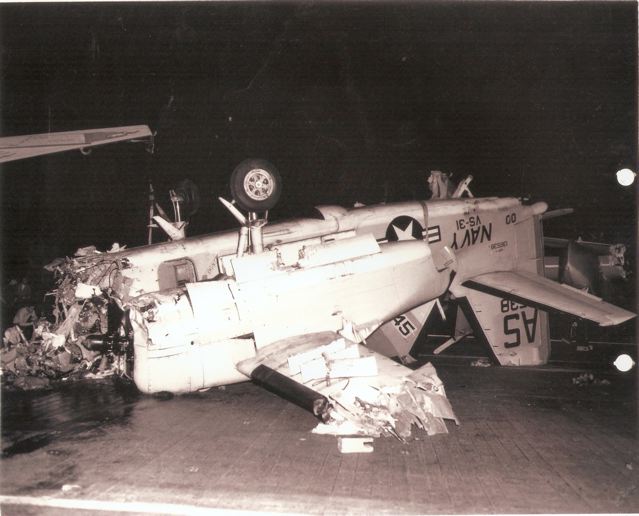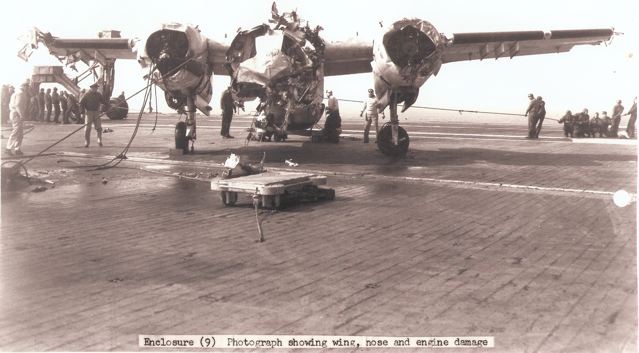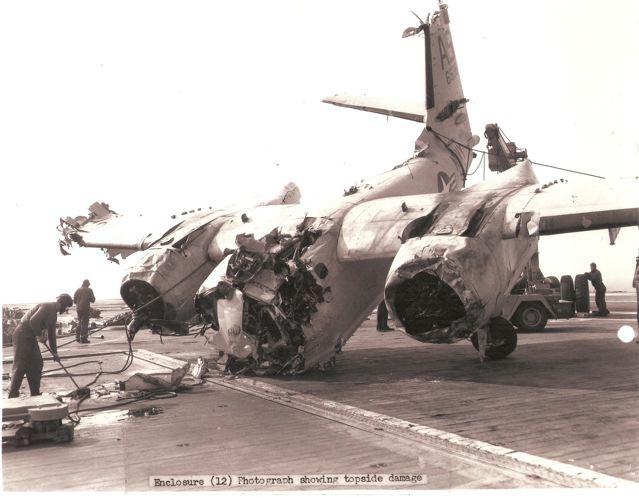The crash occurred because of confusion on the flight deck and slipped communications all along
the line. Most will remember that 1960's was the time of the missile build-up in Cuba. WASP
and our Air Group played on the first team in the game against the Russian ships. That night in
May we set up an exercise to show our intelligence people that we could operate in the dark and
in bad weather. We were to practice CCAs; carrier controlled approaches by radar. Our plane,
#00**, was first' up and we were told to make an approach and wave off 14 mile astern. Don was in
the left seat to gain CCA practice. We launched at dusk.
**Fate at work. #00 is the Air Group Commander's plane. He should have been flying but he was called to observe these exercises. I was Scheduling Officer and couldn't get anyone else to take the flight on such short notice, so I took it. That put us first in the pattens to land.
Later, on deck, the helicopter launch takes place but one helo goes down and returns. The replacement stand-by helo fires up. Don and I begin our CCA approach. In another part of Air Operations, the pressure builds to get the stand-by helo airborne. Questions fly about the status of the deck. 'Green deck for helos' shot back in response several times, eventually gets shortened to simply 'green deck.'
The controller handling our approach overhears 'green deck' and relays to us the news every
young pilot wants to hear; "You have a green deck, cleared for touch and go." I slap Don on the
shoulder. "You take the touch and go, I'll take the final." It's now after 2000 and dark. Don grins and settles in to chalk up a night landing. Life is good.
Most shipmates know the deck is not lighted at night except for the small row of dustpan lights
down the centerline. The pilots' attention is on the parabolic landing mirror that displays the plane's position on the glide slope, a sort of visual Landing Signal Officer. Don is holding glide path and the S2F approaches the fantail. No LSOs are on duty, but a young sailor at the LSO station sees what's about to happen. He takes the initiative and hits the wave-off button. Don and I are
startled and both throw full power to the big engines.
But we're already on the deck and already plowing and grinding a path through all the recovered
helicopters. We start to flip forward, but just about amidships we hit the tractor towing the TF-
COD plane. The grinding stops. It's dark and it's very quiet. I smell fuel and then taste it. lean
hear the wind and Don making small motions. "You OK?" I ask. "Yeah," he says, "but I think
we're on fire. My legs are burning." I tell him I don't think so, because I can begin to make out
outlines and I don't see any flickering. We talk some more and it occurs to me that while we are
having this conversation no one has come near the plane. I reach to take off my helmet, fail, and
tell Don that I know my left arm is broken. I reach around with my right arm, loosen the clasp,
pull off the helmet and lob it out onto the deck. I hear it 'whock whock whock' on the wooden
deck and then a voice. "Jesus! There's somebody alive in there!" A very big sailor produces a
very big knife and begins to cut me out.
I can only repeat what I was told about the events that happened next. The crew quickly
recognized the threat from the nearly full load of ruptured aviation fuel that was by now streaming
in the deck gutters and down the side of the ship. All that training paid off as hoses unraveled,
hatches locked shut and the crew went to work to restore the ship for its mission. I'm sure many
shipmates have stories about what they did in the next two hours. With one spark, the Wasp
would have gone up, engulfed in flames.
I was taken below and attended to. My skipper came down to see me. He told me that a call had
gone out for blood donors and that the line of volunteers snaked all around the hangar deck. A
decision was made that I had to be flown ashore for treatment. The wreckage and fuel was
going to make any launch tough, and this would have to be a night deck launch off the short leg
of the angle. My squadron mate Jesse Markham volunteered to fly. The TF COD was down so
work was needed to tear out a back seat in an S2F to make room for the stretcher. I was
told that a large contingent of the crew lined up in a barrage of fire hoses and played water across
the deck so that risk of fire would be minimized.
We launched. Our Flight Surgeon, Dr. Sullivan had the great job of kneeling over me during the
flight and making sure the transfusions kept flowing. May thunderstorms formed and the bumpy
ride made his job even harder. We landed at Norfolk and a waiting ambulance drove me to the
Portsmouth Hospital. The hospital was brand new and the driver had a problem finding the
entrance. I teased him about it to put him at ease. I was rolled down a naked hallway, passed
under a big white light and went unconscious for three weeks.
I may have spellings wrong, but the Wasp's CO was Captain Konstantine Karabaris, Commander Joe Cady led the Air Group, and Commander Josh Sherman commanded squadron VS 31.
I have lots of funny stories about my hospital stay, and insufficient words to describe how special was my treatment at Portsmouth and then Philadelphia, but that's another tale.
When I recall the whole incident, I really don't remember any pain or regret or sadness. What I always feel is humble and that a whole ship and air group of the U.S. Navy went to so much trouble and took such risks just for me. It would have been a lot safer for everyone to decide against launching a plane from a fuel-soaked angled deck, but that's not how the Wasp chose to play it.
I'll be forever thankful.
A footnote:
Hard as it may be to believe, the accident is not the first thing I think of when I think of the Wasp. What I think of first is a February night in 1959, in port in Boston. An airline flight crew came aboard hoping for a tour. It was time for the evening meal and I asked them to join us. One member of the crew was a beautiful redhead. Commander Frank Greatchus (sp) the ship's Engineering Officer sitting across from us, strongly urged me to look twice. I did. Her name was Odessa and we have been married for 38 years this past August.
While I"m not the only shipmate to have an accident aboard, I may be the only one who met his wife on the Wasp.
The query in the WASPIRIT newsletter shocked me. I was deeply touched that shipmates not only remembered but also cared enough, after all these years, to find out what happened to me.
Well, I'm fine! My co-pilot, Don Rogers, broke both his legs and he is doing well. I did sustain
some damage - all kinds of broken bones and an amputation of my left leg - but my health is
perfect. I've never missed a day's work and I fly fish in some rivers that would knock down a
horse. I have a wonderful wife and three fascinating, grown children."
LTjg Carl D "Pete" PETERSON
[email protected]
DON ROGERS' COMMENTS
"Gordy, Thanks for the email and the opportunity to comment on the crash.
Pete suffered much greater injuries than I did. I had both legs broken (left femur and right tibia/fibia) but with the aid of some most helpful flight surgeons, I was back flying within six months and never lost any flight pay.
After regaining full flight status in 1962, I went on to a typical career, two VP squadrons (18 and 26), a couple of staffs, training command instructor, and XO of NAF Misawa, Japan, retiring after 23 years as a CDR.
CDR Donald "Don" ROGERS
[email protected]
Rudy (Sully) Sullivan Comments: (4/24/11):
Hello,
Just a brief note to comment on the STOOF crash aboard Wasp. I was an AMS2 at the time attached to VS-31. I remember that tragic night very well. Was truly an all hands effort. I was one of the maintenance crew assigned to remove seats and equipment necessary to launch the plane with Lt Peterson off the angle. Remember off-loading helos at Norfolk for a long time.
Go Navy,
Rudy (Sully) Sullivan – US Navy - Retired
Created on ... January 05, 2009





